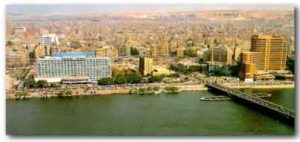Egyptian Cities are the natural result of any civilization where the political organization is well-established. Ancient Egypt was no exception. The cities were related to the various dynasties that shaped the course of civilization.

Political, economic and importantly security reasons were behind these establishments. Some have vanished due to many reasons including the flooding of the Nile, but some remain maintaining their history and heritage.
Niwt was the term used for Egyptian city during the New Kingdom. As early as the 5th Dynasty, the term for a “town” or large village was dmi. Whyt was the term for the village.
Cities were built on the floodplain, as the proximity to the river Nile helped transportation, travel, and irrigation. Prior to 5000 BC, the inhabitants of the Nile Valley were mostly foragers who practiced fishing, fowling, hunting and collecting wild plants.
Farming Community of Egyptian Cities
The first known farming community then occupied a site at the edge of the floodplain of the Nile Delta at Merimda Beni Salama, about twenty-five kilometers to the northwest of Cairo. This was a large village, consisting of about 180,000 square meters and it remained populated for about 1,000 years.
Around 3500 BC, the village of Maadi was established about fifteen kilometers south of present day Cairo, probably as a trade center. Trade items like copper and bitumen were unearthed from this location. It is believed that Maadi was at the end of an overland trade route to Palestine.
The site shows evidence of huts, storage magazines, silos, and cellars. The two towns of Hierakonpolis and Naqada were important. The former had around 2000 inhabitants. The latter was probably an administrative center.
From around 3500 to 3300 BC, the place was characterized by a decline in the Nile floods and flourishing of trade which led to the emergence of many more cities. Abydos, north of Naqada and Hierakonpolis was a significant religious establishment.
It existed as a locus of proto-national power that even controlled parts of the Delta some two centuries before the emergence of the 1st Dynasty.
Memphis
Establishment of the city Memphis was a result of the unification of all the administrative districts at around 3000 BC. Unfortunately, we know only a very little about this city. It shifted eastward due to the invasion of sand dunes and a shift in the course of the Nile. Tell el-Dab’a was a residential town.
During the period of New and Middle kingdoms, Thebes, the city of Amon was the capital of Egypt for almost one thousand years. It was situated in the north eastern part of modern Cairo. The city became prominent as a royal residence and a seat of god Amon. It is a striking testimony to Egyptian culture.
Today, Luxor covers the site where Thebes was situated. As the locus of power shifted to the Nile delta, Thebes went into decline. Tanis became an important royal city during the Third Intermediate Period. It remained the Egypt’s capital till the Arab invasion.
Apart from the main Egyptian Cities, there were also specialized cities for trade. As Egyptian civilization progressed, there appears to have been some seventeen cities and twenty-four towns in an administrative network that linked them to the national capital. The cities, no doubt helped the community to assume the role of a great power in the ancient world.
